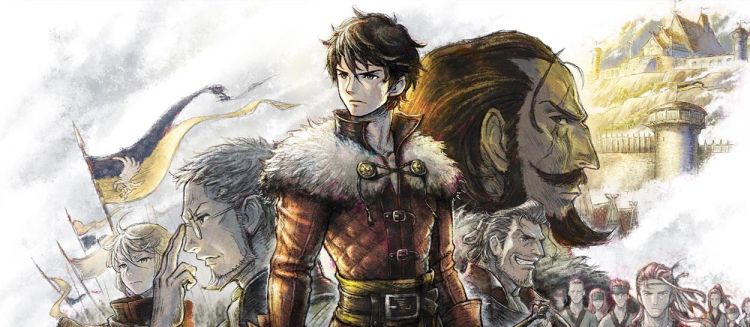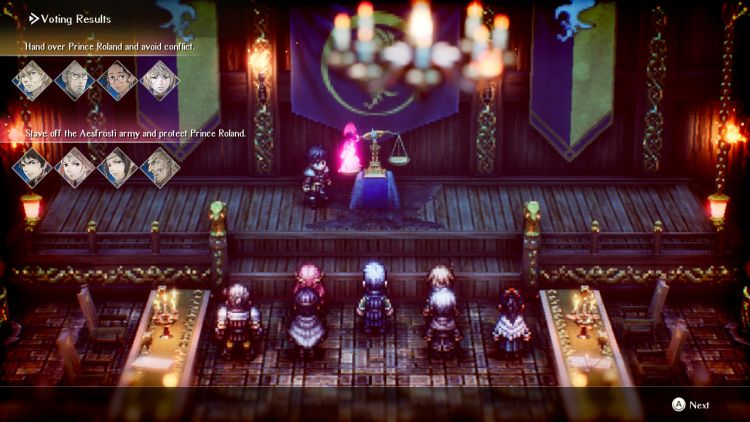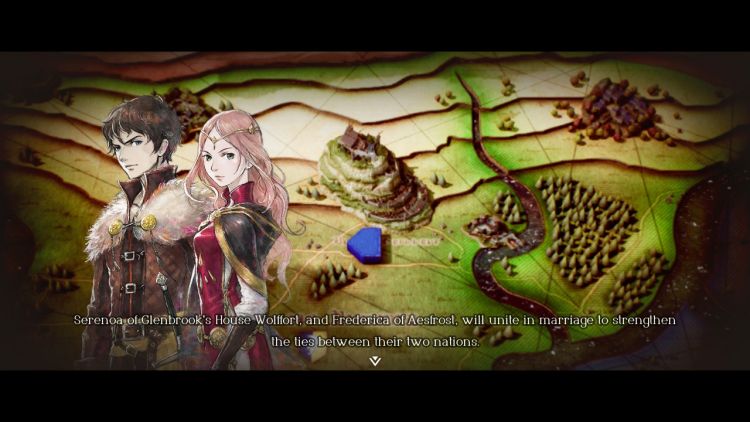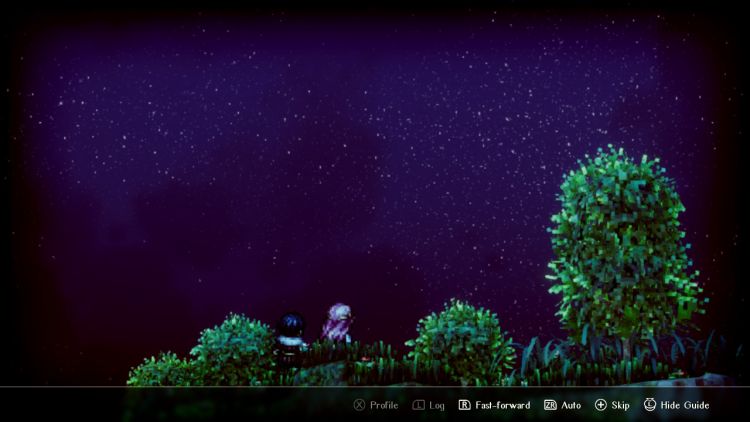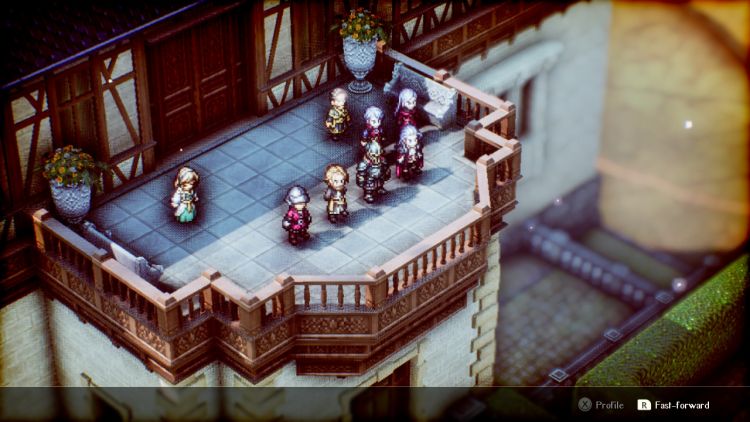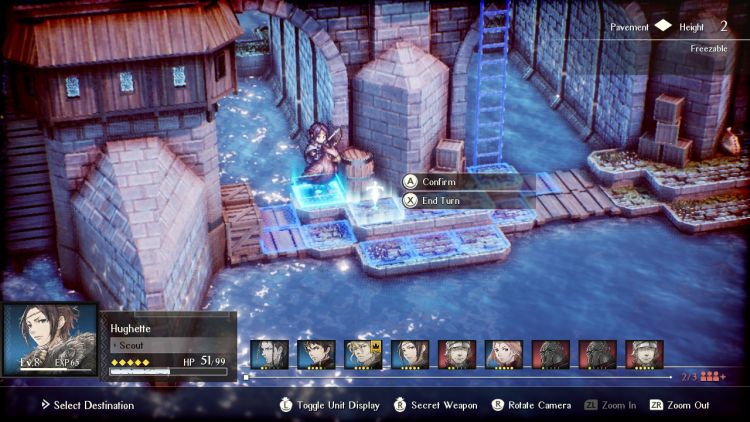For the last few years, Square Enix has been delivering quality RPG experiences to Nintendo Switch owners, and now the latest one has come via Triangle Strategy. I’ve spent months on a particular podcast making fun of the name, but as it got closer and the gameplay/story became more pronounced in trailers, I wondered…could this live up to what it was stating? Could the choices we make in this game really lead us to meaningful paths and endings? The answer you’ll get in this Triangle Strategy Review is very much like the game itself…a matter of perspective.
I want to be clear on something before I get deeper into this Triangle Strategy Review. I DID enjoy the game, and am giving it a solid score as a result. But, it’s certain choices ironically enough that hold the game back from being as good as another game from this team that I liked: Octopath Traveler. But enough beating around the bush, let’s get into it.
Triangle Strategy builds off of what Octopath did before it, take a deep RPG look at things, twist them around in fun ways, and delivers a satisfying experience. In this case, though, it plays more like Final Fantasy Tactics in terms of having a large squad that can traverse an open field of battle, all the while having a story that is not unlike a certain Fire Emblem game where key choices will diverge your path to one thing or another. But in this case, it does that choice multiple times and WILL affect your gameplay experience for the better…and the worse.
The game takes place in the realm of Norzelia, where three mighty kingdoms have brokered an uneasy peace. You play as one of the main houses of the Kingdom of Glenbrook, known as House Wolffort, specifically the character of Serenoa, who is the son the current ruler, and per a recent agreement, you are to marry Frederica of Aesfrost (a rival nation) to ensure that the peace is kept. Naturally, things start out smooth and then go horribly wrong. Leaving Serenoa, Frederica, and their allies to try and figure out how to stay alive, save their domain, and bring peace to the land…if that’s even possible.
You’re going to hear a lot of references to Game of Thrones as I talk about the story. Mainly because in terms of scale, characters, and how everything weaves in and out of one another, it feels like something George R.R. Martin might have written. And this is easily one of the biggest highlights of the story. Because through both the overt story as well as story “notes” that you can read at any time, you gain a greater understanding of the world, those who are there and aren’t, and why it all fits together the way it does.
And another reason this is so important is that the grand scale of the story ensures that the choices you make, both big and small matter. Because EVERYONE is going to be affected by the choices you make, so, let’s get to the Scales of Conviction. You know…what SHOULD’VE been the name of the game?
At key points in the narrative, you’ll be given a choice. Serenoa, whose house has a kinship with others and believes in “choice by committee” uses the Scales of Conviction so that all voices can be heard, and then a choice made by who believes the most (numerically speaking) in a certain path. BUT, the twist here is not just the branching paths. It’s that YOU can help sway people to your side if you have a certain set of convictions.
In the game, everything you do, from certain dialogue chats, to buying things at the story, to battles you do, upgrading characters, and so on will affect how your comrades of the House will talk with you during these key moments. If you are “on their level” with convictions, you’ll be able to easily persuade them to the path you want to take. But, if you aren’t on their level, you’ll hear that “you have a better chance of convincing a stone wall”. Meaning you won’t sway them.
It may sound easy to make sure you’re on their level, but the game doesn’t reveal in its first run-through what you are improving, and which dialogue choices (or path choices) will affect what setting. For me personally, I only had one time when the scales went against my choice. But…that one choice…literally changed everything in the game for me. I tried multiple times to fix that and get the scales to tilt towards me…but it never worked, and so I had to just swallow my pride and move on.
And that’s the thing. No matter what you do, no matter which way the scales go, you’ll have to follow the story where it goes until the next branching path.
But thankfully, the game really does allow you to go on these branching paths, and there are even branches that aren’t tied to the scales themselves. While talking with my co-hosts on The Nintendo Entertainment Podcast (we all got the game), we each got to talk about the paths we did and didn’t take, as well as what battles we got because of the choices we did. There are a true variety of locations and battle types to do, and you’ll want to do multiple playthroughs not just to do all the paths, but to see just how different your choices can be and how it affects everyone.
That’s a good enough jump to talk about the gameplay. As noted, it plays like Final Fantasy Tactics. You’ll be given a choice of a set of characters, and then have to move them along a battlefield that is almost always different (there are a few repeat locations, but they change it up enough to feel fresh), and you’ll need to be smart in order to survive. Unlike games like Fire Emblem, there is no permadeath, which is honestly a relief because these levels, at times can be overwhelming. The picture above for example is from the final level of my path, and it took me three playthroughs to survive it because of the difficulty.
Thankfully, Triangle Strategy does well in giving you options to not just level up your character, but improve their stats, abilities, and even improve their class rank in order to make them tougher for the battles to come. Add that to a menagerie of equipment items that you can hold and you have a very robust RPG that you can play several different ways without getting bored. And that says nothing of the characters themselves.
As noted, you are part of the grand house of Norzelia, and so you have a set of characters to start the game with. But, based on your path, your convictions, and the natural flow of the game itself, you’ll get more characters. Each one adds something new to the mix, and it’ll be up to you to decide which party members to bring. Each has their plusses and minuses, and their abilities are all different even when they’re similar classes like archers. So you’ll need to figure out what playstyle you want to do and which characters to bring to the mix to invoke it. Or, to change things up on the fly so that you can fit the needs of the level.
I do want to note story-wise that how they handled these characters is very nice. My favorites being Serenoa and Frederica, their arranged marriage may have forced them together, but by the end of my path they had a wonderful, and natural, relationship that I didn’t want to see end. Add to that, many of the “side characters” you interact with have their own “Character Stories” that help you see more about this world. For example, there’s a Shamaness named Ezana, who we find out was forced on the run by the Holy State of Hyzante because of her abilities being “deemed foul by the goddess.” She lost the man she loved as a result, but they are later reunited if you advance far enough with her. They didn’t have to do that, but they did, and I’m glad.
Hearing these character stories again reminds me of Game of Thrones (or even something like Full Metal Alchemist) where all the characters, big and small, have a role to play. And seeing Serenoa try to do right by both those in his care, and those across Norzelia whom he’s sworn to help is a big part of the game and very much will influence your choices.
Case in point, in the early parts of the game, you only have two choices to make. They start out small to give you the lay of the land, but then, they grow in escalation quickly, and you have to make hard choices. For me, there were some choices that were easy to make, but then, there was one that I knew I HAD to do for a character I liked, as I knew they’d never forgive me if I didn’t. And then, at two of the last choices, I struggled with what to do, and where to go. That’s the beauty of Triangle Strategy when it’s firing on all cylinders. You have the characters you want to side with, and you know the choices…but you don’t know which path is right…which is wrong…and which one the game wants you to do.
That, sadly, is where this Triangle Strategy Review takes a turn. Because while I did very much enjoy the game, the reveal of something by my NEP co-hosts, and how my personal path ended very much soured part of my experience in the game.
Because if you have not heard, while your choices absolutely matter in the game, and there are four endings to facilitate that fact…there is a “Golden Route” that the title does WANT you to take…should you do everything right. Yes, the “true ending” of the game is only one you can do IF you trip certain “flags” both in combat on one level, and the Scales of Conviction on the other. While, in theory this isn’t a bad thing, it’s not stated what these flags are, and given that the game is about YOUR choices, this kind of ending shouldn’t exist. It can exist as AN ending, but the “golden” or “true” one. Plus, if you miss a single flag (as I did in that failed Scales chat I mentioned), you can’t go on that path anymore. That’s a bit restrictive, and my NEP brethren were very much with me when I noted that it makes the other endings feel hollow.
While I won’t spoil them, I’ll tell you that one of my co-hosts (who did a different path than me) had an ending that was satisfying, but it showed the hypocrisy of certain characters. For me, my ending had some happy moments, but some incredibly sad ones, and felt hollow given all I had done for some of these characters.
And that’s not even getting into how the story at times feels forced in getting from one point to another.
This is the biggest spoiler I’ll do here, you’ve been warned. Late in the game, your best friend and soon sole prince of Glenbrook, Roland decides to do something very out of character. Throughout the whole game, he has fought for “the little guy” and even Serenoa notes that he’s settled the squabbles of the common folk “with a single word”. But then, at a key Scales of Conviction, he does a 180 and demands that you all side with the Holy State of Hyzante because it’s the only way to have ‘freedom for all’. Except, through all the chapters and characters stories we’ve had up to that point…we know that’s a lie. Not the least of which were via Frederica’s people of the Roselle, who are literal slaves to Hyzante because of “sins” that we learn is a lie.
Not to mention in key missions he was a part of, we heard of the discontent in Hyzante and how it’s a “believe this or be punished” culture. And when asked about the Roselle, he noted it was a “small price to pay for freedom”. That took me (and my co-host) so aback it made us mad. He had a brother who would say that easily. But not Roland. The story did that, though, so we could have a three-branched path. And yet, when I (and my co-host) went against that path, Roland either didn’t care and snapped right back to his true character, or, did something that also proved his hypocrisy on the matter.
Also, they pulled a Game of Thrones move in terms of the heritage of a certain character, and yet that only apparently plays out in one of the storylines, so why have it? Oh, and in my path, a very key character close to Roland is straight-up ignored because…reasons…?
We’re not saying the story was bad. All my co-hosts enjoy the game, but when you have a game with multiple endings, there can be “bad endings,” but there should be just as many good ones (see: Chrono Trigger). But here, there are basically three “lukewarm endings” that tells you, “you did alright, but you could’ve done better,” and that shouldn’t be the path they took.
In terms of gameplay, Triangle Strategy does a lot right, but it can get fumbled at key points. For example, while you do get extra characters to play with, at times, they come en masse, and that makes you have to be very careful about who you train as it could cost you in the end. Furthermore, a great feature of the game is “Mock Battles” in order to grind levels, get materials, make money, and so on. But at times, you can be grinding for some time in order to get what you need to level up, and by the end, I was very much over it, especially when the payoffs weren’t worth the stress of the levels themselves.
Also, in the main battles, you can be very restricted in terms of how many characters you bring, even though Mock Battles have you able to use more multiple times. In my final battle, I was overwhelmed by enemies and their numbers and had to get REALLY creative to win, but if I had one or two more people? It would’ve been difficult, but not quite as challenging.
Add to that, the UI and graphics (the graphics aren’t bad for the record, just take some getting used to) can make it so that you really need to pay attention to who’s next, where is everyone, and how much damage you’re actually doing, and so on. I’ve almost lost it when I SWEAR the UI was saying I would kill a foe, but no, they had like one or two HP left. I also had multiple issues navigating the combat screens at times because I thought I was locked into something, but I wasn’t.
All in all, Triangle Strategy was a very worthy game, and I’m glad I spent 36 hours in my playthrough of it. It was a grand story, a fun challenge, and had characters I very much enjoyed meeting. But, the story did trip over itself, and specific gameplay mechanics could’ve used a bit more refining. Still, if you’re looking for a new and long RPG experience, you should check this title out.
Triangle Strategy Review
Summary
Triangle Strategy brought very deep and compelling narratives and gameplay elements to this Nintendo Switch title. It doesn’t always succeed in what it’s trying to do. But overall, it’s a fun experience.
-
Triangle Strategy Review


